April 2020 LIP of the Month
Volyn Large Igneous Province, East European craton, ca. 570 Ma
Anna Nosova,
Institute of Geology of Ore Deposits, Petrography, Mineralogy and Geochemistry, Moscow, Russia
This is based on the following:
Nosova, A.A., Kuz’menkova, O.F., Veretennikov, N.V., Petrova L.G., Levsky L.K. (2008) Neoproterozoic Volhynia-Brest magmatic province in the western East European craton: Within-plate magmatism in an ancient suture zone. Petrology, v. 16, p. 105–135.
Nosova A.A., Veretennikov N.V, and Levskii L.K., (2005) Nature of the Mantle Source and Specific Features of Crustal Contamination of Neoproterozoic Flood Basalts of the Volhynia Province (Nd-Sr Isotopic and ICP-MS Geochemical Data), Dokl. Earth Sci., v. 401, p. 429–433.
Kuzmenkova, O.F., Shumlyanskyy, L.V., Nosova, A.A., Voskoboynikova, T.V., Grakovich, I.Yu. (2011). Petrology and Correlation of Trap Formations of the Vendian In the Adjacent Areas of Belarus and Ukraine, Lithosphere, v. 35 (2), p. 3-11.
Shumlyanskyy, L., Nosova, A., Billström K., Söderlund U., Andréasson, P.-G., Kuzmenkova, O. (2015). The U-Pb zircon and baddeleyite ages of the Neoproterozoic Volyn Large Igneous Province: implication for the age of the magmatism and the nature of a crustal contaminant, GFF, v. 138, p. 17-30.
The East European Craton (Baltica) was a part of the Rodinia supercontinent in the Neoproterozoic time. Baltica was attached to Amazonia and Laurentia and was rifted away during the Ediacaran. Episodes of the most intensively basalt and alkaline magmatism at the Northwestern Baltica occurred during the Ediacaran between 626 and 550 Ma, is part of the Central Iapetus Magmatic Province (CIMP) and was linked with opening of the Iapetus Ocean (e.g. Tegner et al., 2019).
The most voluminous volcanic area at Baltica, connected with the formation of the Iapetus Ocean, was the Volyn Large Igneous Province. This province, situated along the Trans-Europian Suture Zone (Tornquist Zone) in the Western margin of East European Craton, occurs as a typical continental flood basalt province related to the Neoproterozoic break-up of Rodinia supercontinent and separation of Baltica and Amazonia (Fig. 1).
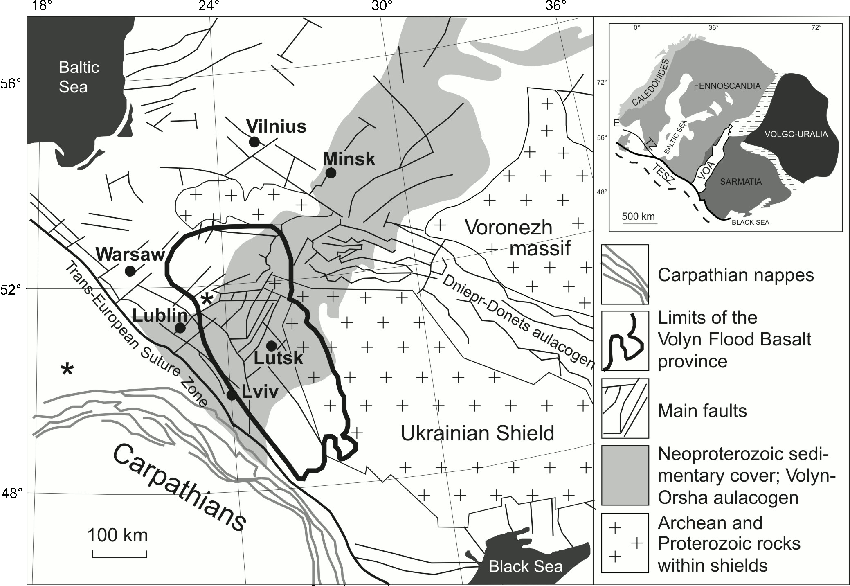
Figure 1. Schematic map of the Volyn LIP. Numbers in circles: 1 – Devonian Prypyat aulacogen; 2 – Brest depression. Ar – Archaean Dniester-Bug domain of the Ukrainian shield; Pr – Palaeoproterozoic domain. Area located to the west of the Ukrainian shield is known as Volyno-Podolian monocline. Inset map: VOA indicates Volyn-Orsha depression; E stands for Egersund dyke swarm and TZ – for Tornquist zone After Shumlyanskyy et al. (2015). TESZ = Trans-European Suture Zone.
The occurrences of pre-Devonian basaltic magmatism in the western Russian platform, at Volhynia, have been known since the 18th century. However, only extensive drilling conducted in the 1950–1960s allowed scientists to elucidate the true scales of Ediacaran magmatism at the western East European craton and to identify the ancient trap province (Ushakova, 1962; Makhnach and Veretennikov, 1970; Nikishin et al., 1996).
The Volyn LIP occupies an area over 200,000 km2 (800 km long at 300 km wide in the central part), including eastern Poland, western Belarus, northwestern Ukraine, and Moldova (Fig. 2).
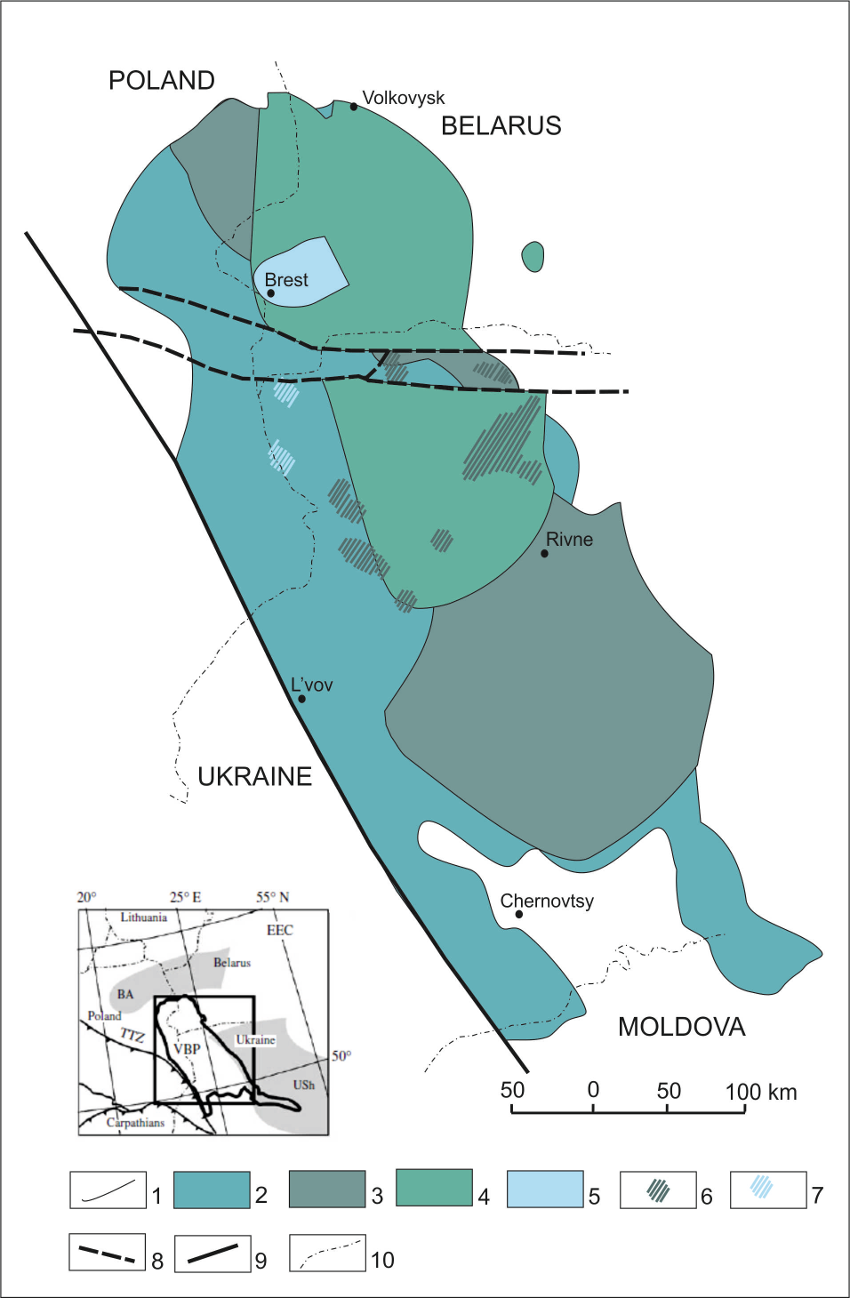
Figure 2. Schematic map of the Volyn LIP. (1) Lava and tuff facies. Basalts and their tuffs: (2, 3) olivine basalts of the lower sequence: (2) low-Ti, (3) moderate-Ti, (4) high-Ti tholeiitic basalts of the upper sequence; (5) felsic and intermediate rocks; (6, 7) dolerite sills: (6) high-Ti HT2 dolerites in the Riphean Poles’e Group; (7) low-Ti intraformational LT; (8) faults; (9) Teisseyre–Tornqvist line; (10) state boundaries. Inset shows: (BA) Belarusian anteclise, (EEC) East European Craton, (VBP) Volyn LIP province, (TTZ) Teisseyre–Tornqvist Zone, (USh) Ukrainian Shield. After Nosova et al. (2008).
The volcanic sequences in northern and southern parts of the Volyn LIP are different (Fig. 2).
The northern part of the province (Podlyassk–Brest depression) is characterized by bimodal volcanism, with a sequence consisting of the lower (50– 300 m thick) and upper (50–200 m thick) basalts and intervening felsic volcanics (50–110 m thick). Due to a small areal occurrence, the felsic rocks only constitute a few per cent of the total volume of the Volyn province. The lavas and tuffs in the southern part of the province (Volhynia) have an essentially ma?c composition and this sequence consists of three basaltic units: two thin lower units and a thick, up to 500 m, upper unit. Volcanic sheets are built up of a series of lava ?ows (from 1 to 8) from a few to few dozen meters thick with tuff intercalations.
The hypabyssal rocks occur as sills and dykes of dolerites and gabbro-dolerites and are contained in the underlying Riphean deposits and the Vendian tuffo-lava sequence. They occur mainly in the Volhynia part, being restricted exclusively to the Riphean Volhynia–Orsha aulacogen.
Recent dating of zircons from the least contaminated variety of the Volynian basalt (the high-Ti basalt) and zircons, seemingly of a magmatic origin from the rhyolitic dacite, yielded the ~ 570 Ma age, the same as the time of eruption of volcanic rocks (Shumlyanskyy et al., 2015) (Fig. 3).
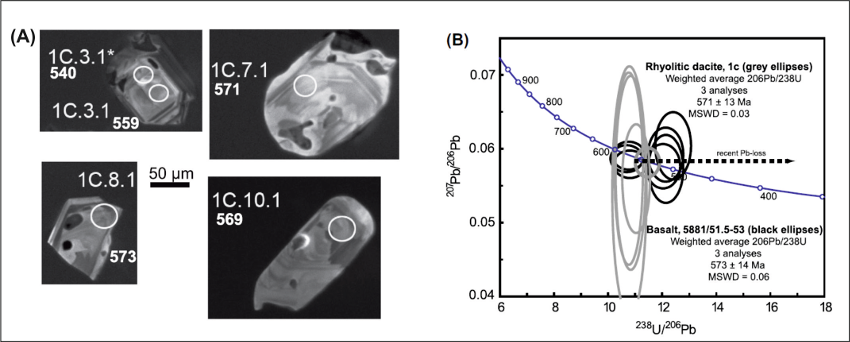
Figure 3. A – CL images of igneous population of zircons separated from a rhyolitic dacite sample 1c. Numbers correspond 206Pb/238U age in Ma; B - Tera–Wasserburg diagram showing data for zircons from the high-Ti basalt sample (black symbols), and for zircons from the rhyolitic dacite sample 1c (grey symbols). After Shumlyanskyy et al. (2015).
In general, the Volyn province is composed mainly of the following rock types (Table 1): locally distributed picrites (Fig. 4), alkaline olivine basalts, with dominant low-Ti ( <1.10–2.0 wt % TiO2) varieties, and tholeiites, with dominant high- Ti (2.0–3.6 wt % TiO2) rocks. The hypabyssal rocks comprise low-Ti olivine dolerites (1.2–1.5 wt % TiO2) and high-Ti olivine gabbro-dolerites (3.0– 4.5 wt % TiO2). The olivine basalts were replaced with time by the tholeiite basalts. They were separated by the eruption of dacites and rhyodacites.
The whole-rock Mg#, ranging between 69 and 73 in picrite, gradually decreases upwards and reaches 35–60 in high-Ti tholeiites and intrusive dolerites.
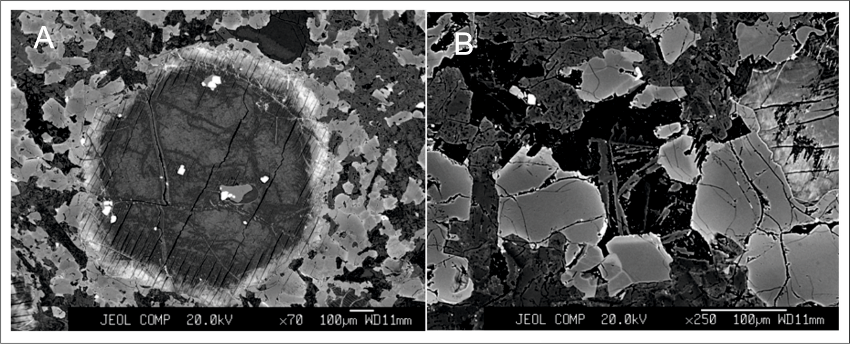
Figure 4. Picrite, A - olivine phenocryst surrounded by clinopyroxene, and B - K-feldspar microliths into glass interstitial between clinopyroxene and plagioclase, BSE images.
The olivine basalts have weak negative anomalies of Nb (Nb/La = 0.7–1.0) and Ti, and moderately fractionated REE patterns [(La/Yb)n = 4.1–4.6] at similar fractionation of LREE and HREE [(La/Sm)n = 1.7–2.2; (Gd/Yb)n = 1.6–1.8]. The tholeiites show negative Nb and Ti anomalies and are characterized by the more fractionated REE [(La/Yb)n = 4.3–6.0], especially HREE [(Gd/Yb)n = 1.7–2.3] patterns.
The high-Ti gabbro-dolerites markedly differ in geochemistry from other rocks of the Volyn LIP. They are enriched in LILE, HFSE, and have no negative anomalies of Nb (Nb/La = 0.9–1.1) and Ti. They have strongly fractionated REE patterns [(La/Yb)n = 7.3–8.9], with more significant HREE fractionation [(Gd/Yb)n = 2.3–2.9 and (Dy/Yb)n = 1.7–1.9] at moderate LREE fractionation of (La/Sm)n = 2.1.
The Sr and Nd isotopic compositions of the Volyn LIP basalts are typical of the basalts from within-plate magmatic provinces (Fig. 5).
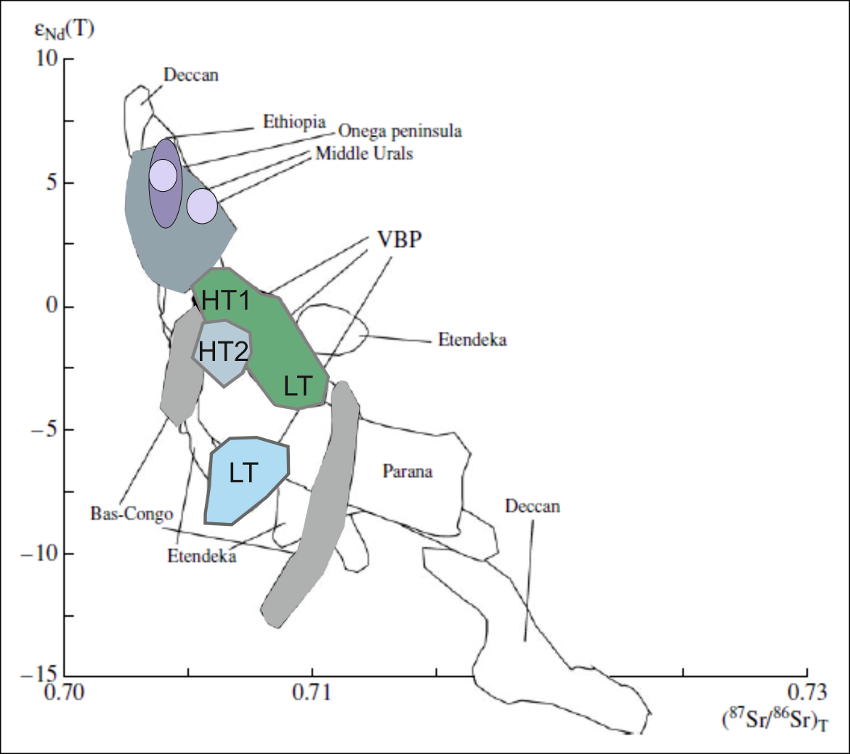
Figure 5. Sr and Nd isotopic composition in the basalts of the Volyn LIP and rocks of some within-plate magmatic provinces. Compositional fields of the Neoproterozoic magmatic provinces are shown by gray fields. Data were taken from: Natkusiak basalts of the Franklin belt (732 Ma) (Dupuy et al., 1995); basalts from western Congo (925 Ma) (Tack et al., 2001); Middle Urals (608–560 Ma) (Karpukhina et al., 2001); Onega peninsula (670 Ma) (Nosova et al., 2008); Deccan (66 Ma) (Chandrasekharam et al., 1999), Ethiopia (ca. 30 Ma) (Pik et al., 1999); Parana and Etendeka (130 Ma) (Turner et al., 1999; Peate and Hawkesworth, 1996; Ayalew et al., 2002).
Table 1. Geochemistry and Sr-Nd isotopic signature of the Volyn rocks
|
Rocks |
Picrite, flows |
Low-Ti olivine basalt, flows |
Moderate-Ti olivine basalt, flows |
Low-Ti tholeiite flows |
High-Ti tholeiite flows |
High-Ti Gabbro-dolerite sills |
Low-Ti dolerite, sills |
|
Mg# |
0.69-0.70 |
0.45-0.50 |
0.46-0.60 |
0.41 |
0.40-0.46 |
0.40-0.50 |
0.50-0.60 |
|
TiO2, % |
0.3-0.4 |
1.1-2.0 |
2.0-3.1 |
1.3-2.0 |
2.0-3.2 |
3.0-4.5 |
1.3-1.4 |
|
Ni, ppm |
264-476 |
90-110 |
30-60 |
41 |
30-80 |
50-70 |
130-140 |
|
Cr, ppm |
1420-2440 |
100-170 |
30-100 |
34 |
10-50 |
50-80 |
60-100 |
|
Nb/La |
0.6-0.8 |
0.7-1.0 |
0.2 |
0.6-0.7 |
0.9-1.1 |
0.9-1.2 |
|
|
La/Yb(n) |
4.3-4.7 |
4.1-4.6 |
6.0 |
4.3-6.0 |
7.3-8.9 |
7.3-8.9 |
|
|
La/Sm(n) |
2.9 |
2.1-2.5 |
1.9-2.1 |
2.6 |
1.9-2.1 |
2.1 |
2.9-3.2 |
|
Gd/Yb(n) |
0.8 |
1.6-1.7 |
1.6-1.8 |
1.7 |
1.7-2.3 |
2.5-2.9 |
1.7-1.9 |
|
εNd(550) |
-11…-12 |
-2.7…-6.6 |
+0.2…-3.5 |
-0.7…-1.3 |
-2.6…-2.5 |
-5.8…-5.9 |
The basalts show a trace element signature, mainly represented by negative Nb-Ta anomalies, which indicate a crustal contribution. These geochemical features are due to either crustal material assimilation or can be related to metasomatism of the subcontinental lithospheric mantle by past subduction. An assimilation of crustal rocks at the upper crust level is more consistent with Sr-Nd isotopic systematics of the basalts and dacite than a contribution of recycled crustal material.
The spatial distribution of Nd isotopic parameters (εNd(570)) in the basalts and felsic rocks (Fig. 6) demonstrates that the basalts with the least radiogenic Nd isotopic composition are spatially related to the felsic rocks. Northward and southward away from dacite and rhyolite occurences, the basalts show a distinct trend of increasing εNd(570) up to the appearance of positive values. HTi tholeiites from the upper sequence, which erupted after the eruption of rhyolites and dacites, have a more radiogenic Nd isotopic composition than the LTi basalts from the lower sequence, which formed prior to the felsic rocks. Picrites which are located at the bottom of the Volyn LIP section and represent the initial stage of the province evolution, are characterized by extremely low radiogenic Nd isotopic composition: εNd(570) values are -10.8 … 12.2, and have δ18O values of 6.7-7.8 ‰ which are significantly higher than typical for mantle rocks. Such a relationship indicates crustal contamination of the picrites and basalts.
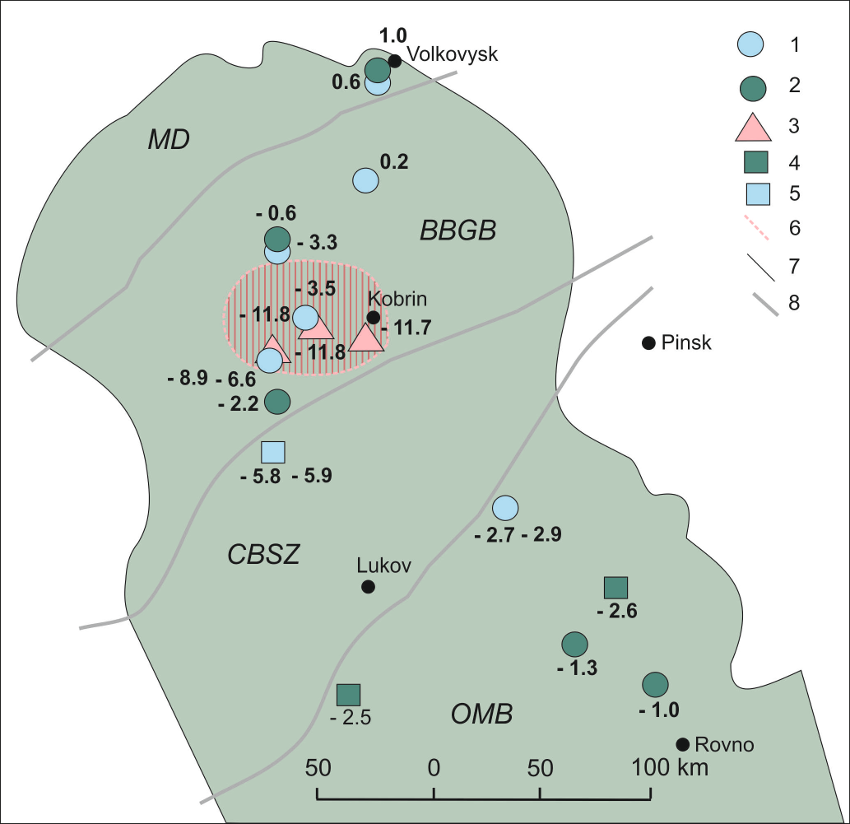
Figure 6. Schematic map for the distribution of the εNd(570) values in the basalts and felsic rocks of the Volyn LIP. (1) LT basalts from the lower sequence, (2) HT basalts from the upper sequence, (3) felsic rocks, (4) HT gabbro-dolerites of sills, (5) LT dolerites of sills; (6–8) outlines of the distribution areas of (6) felsic rocks, (7) VLIP, (8) structural–tectonic zones of the Volyn LIP basement: BBGB - Belarusian–Baltic granulite belt, OMB - Osnitsk–Mikashevichi belt, GBSZ - Borisov–Ivanov belt, MD - Mazur domain. After Nosova et al. (2008).
Felsic rocks have typical crustal Nd and Sr isotopic characteristics (Table 1). This indicates that a combination of thermal characteristics and dynamics of magma ascent allowed large-scale melting of the upper crust under the effect of basaltic melts. The felsic rocks have high contents of Mg, Ti, and Fe coupled with high contents of Si and K, which is probably related to their formation through mixing of basaltic and felsic crustal melts.
The central part of the Volyn LIP was superposed on (1) the junction zone of the ancient (Late Archean–Early Paleoproterozoic) and relatively young (late Paleoproterozoic) subcontinental lithosphere and (2) the axial zone of the Mesoproterozoic Volhynia–Orsha rift structure. This position ensured a high permeability of its lithosphere and, correspondingly, its saturation in asthenospheric melts; mixed asthenospheric–lithospheric melts that reached the surface and contained a significant fraction of deep-seated melts. The heat of the ascending basaltic melts triggered the melting of crustal material and the formation of felsic rocks.
References
Ayalew, D., Barbey, P., Marty, B., et al. (2002). Source, Genesis, and Timing of Giant Ignimbrite Deposits Associated with Ethiopian Continental Flood Basalts, Geochim. Cosmochim. Acta 66 (8), 1429–1448
Chandrasekharam, D., Mahoney, J.J., Sheth, H.C., Duncan, R.A. (1999). Elemental and Nd–Sr–Pb Isotope Geochemistry of Flows and Dikes from the Tapi Rift, Deccan Flood Basalt Province, India., J. Volcanol. Geotherm. Res. 93, 111–123
Dupuy, C., Michard, A., Dostal, J., et al. (1995). Isotope and Trace-Element Geochemistry of Proterozoic Natkusiak Flood Basalts from the Northwestern Canadian Shield, Chem. Geol. 120, 15–25
Karpukhina, E.V., Pervov, V.A., Zhuravlev, D.Z. (2001). Petrology of the Subalkaline Volcanism in the Western Slope of the Ural Mountains—An Indicator of the Late Vendian Rifting, Petrology 9, 415–436
Makhnach, A.S., Veretennikov, N.V. (1970) Volcanogenic Complexes of the Upper Proterozoic (Vendian) of Belarus (Nauka i Tekhnika, Minsk) [in Russian].
Nikishin, A.M., Ziegler, P.A., Stephenson, R.A., et al. (1996). Late Precambrian to Triassic History of the Eastern European Craton: Dynamics of Sedimentary Basin Evolution, Tectonophysics, v. 268, p. 23–63.
Nosova, A.A., Larionova, Y.O., Veretennikov, N.V. et al. (2008) Correlation of neoproterozoic volcanism in the southeastern White Sea region and western Urals: New age data on the Solozero basalts (Onega Graben). Dokl. Earth Sc. 419, 303–307. https://doi.org/10.1134/S1028334X08020268
Peate D.W., Hawkesworth, C.J. (1996). Lithospheric to Asthenospheric Transition in Low-Ti Flood Basalts from Southern Parana, Brazil, Chem. Geol. 127, 1–24
Pik, R., Deniel, C., Coulon, C., et al. (1999). Isotopic and Trace Element Signatures of Ethiopian Flood Basalts: Evidence for Plume–Lithosphere Interactions, Geochim. Cosmochim. Acta 63, 2263–2279
Tack, L., Wingate, M.T.D., Liegeois, J-P., et al., (2001). Early Neoproterozoic Magmatism (1000–910 Ma) of the Zadinian and Mayumbian Groups (Bas-Congo): Onset of Rodinia Rifting at the Western Edge of the Congo Craton, Precambrian Res. 110, 277–306
Tegner, C., Andersen, T. B., Kjøll, H. J., Brown, E. L., Hagen-Peter, G., Corfu, F., et al. (2019). A mantle plume origin for the Scandinavian Dyke Complex: A “piercing point” for 615 Ma plate reconstruction of Baltica? Geochemistry, Geophysics, Geosystems, 20, 1075– 1094. https://doi.org/10.1029/2018GC007941
Turner, S.P., Kirstein, L.A., Hawkesworth, C.J., et al., (1999). Petrogenesis of an 800 m Lava Sequence in Eastern Uruguay: Insights into Magma Chamber Processes Beneath the Parana Flood Basalt Province, J. Geodynamics 28, 471–478
Ushakova, Z.G. (1962) Basic and Ultrabasic Magmatic Formations of Platforms and Mobile Belts (VSEGEI, Leningrad) [in Russian].
